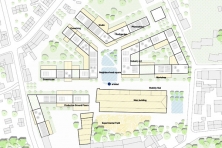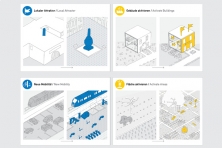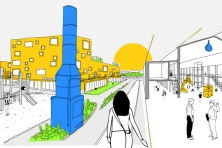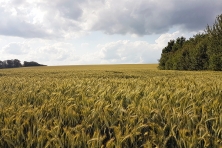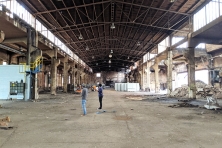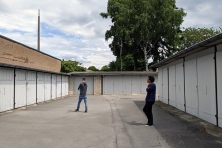Bergisch Plugin
Bergische Kooperation (DE) - Lauréat
DONNÉES DE L'ÉQUIPE
Représentant de l'équipe : Nikolai Werner (IT) – urbaniste ; Associés : Daniel Blanchereau (DE), Vassilissa Airaudo (FR) – architectes ; Moritz Scharwächter (DE) – étudiant en architecture
Team Pesto
+4915734733630 – mail@teampesto.de – www.teampesto.de
Voir la liste complète des portraits ici
Voir la page du site ici

V. Airaudo, N. Werner, M. Scharwächter & D. Blanchereau
VIDEO (par l'équipe)
INTERVIEW (en anglais)
1. How did you form the team for the competition?
We got to know each other during our studies of architecture in 2011 at the Bergische Universität Wuppertal. After our studies we wanted to continue working together on projects and so we decided to participate in the Europan 15 as our first team project. Already during our workflow at university, we didn't want to miss a good meal, something simple, fast, delicious, warm and varied should be cooked. Pasta with pesto quickly established itself in our team. This became a ritual by taking time to exchange thoughts together. This should be the beginning of Team Pesto.
2. How do you define the main issue of your project, and how did you answer on this session main topic: the place of productive activities within the city?
The task is to develop a holistic approach to the development of the bergisch cooperation areas in Ratingen, Wülfrath, Hilden and Solingen. This development should be an impulse for further cities to network more closely with each other and to form a common cooperation area. In response to this task, we have developed planning principles that define the framework conditions and the necessary points for further development that we believe a productive city in the bergisch cooperation area must include. The criteria are bundled in plugins that close the missing productive gap within the cities. The plugin is inserted into the cities in a visual way and improves the specific local conditions of the neighbourhood towards a productive city. For this purpose, criteria have been defined that create an environment in which the residents can develop productively. Depending on the plugin, there are various ways of implementing these criteria in order to activate the different levels of the neighbourhood. There are overall plug-ins that provide the ecological, economic, socio-cultural and functional framework for a productive city.
3. How did this issue and the questions raised by the site mutation meet?
The location "Bergische Kooperation" includes the overall cooperation framework and the four very different individual sites Hilden, Ratingen, Solingen and Wülfrath. By developing the plug-ins, we have managed on the one hand to develop common planning principles for all individual locations and on the other hand to show in the drafts how differently these can be implemented, adapted to the different locations. When developing the plugins, we have always taken both scales into account, that of the cooperation area and that of the individual locations. The location in Solingen, for example, is an old industrial site with factory buildings, the location in Wülfrath is an agricultural area. This range of urban planning issues inspired us in the development of the holistic solution approach.
4. Have you treated this issue previously? What were the reference projects that inspired yours?
As a group, we worked on the topic of the productive city together at the university and in an interdisciplinary summer school. In the process there were always different aspects to which we paid special attention. For example, the energy-efficient city or the water-sensitive open space concept. As employees, we have also worked on a project that involved integrating productive ground floor areas into residential properties.
5. Urban-architectural projects like the ones in Europan can only be implemented together with the actors through a negotiated process and in time. How did you consider this issue in your project?
The involvement of local actors and users plays a very important role in our team. Without the early involvement of the users in the planning process, a successful integration of the project cannot be achieved. We see our submission draft for the Europan 15 as a pre-draft that must be worked out more concretely with the users and clients in the further planning process until a possible realisation. Only with their support the project can function in the long term, be anchored in the city and accepted.We have formulated different approaches for the four study areas. In Hilden, the neighbourhood has so far been dominated by garages and car parks. In order to create space for the productivity of the neighbourhood, the users of the garages have to be relocated. For this purpose, the empty upper floors of the post office building will be temporarily used while the garages are demolished and construction work begins. As soon as the monolith at Bahnhofsstraße is completed, the garage users will move to the productive ground floors. The planning area in Solingen is located on an abandoned industrial site of the former Grosmann factory in the immediate vicinity of the Korkenziehertrasse, but a direct connection to it is currently not existing. In order to direct the attractiveness for users of the route towards our planning area, a new connection is being created. The no longer usable building halls of the former factory will be demolished. The main building will be renovated and activated. So the weekly market can take place in the hall in case of bad weather but also flea markets, fairs, balls and even concerts can take place here. Permanent users will gradually move into the hall, who will enliven the hall during the week and work productively on its output. In order to make the area in Ratingen more urban and productive, a landscape park is being created, which connects the already existing sports activities and at the same time creates a direct connection to the western part of the city as well as to the existing industry. The active belt will strengthen the productivity of the users and ensure a green space that creates healthy living conditions for the development of the neighbourhood. It creates an open space for recreation, which in turn is necessary for productivity. The productive neighbourhood in Wülfrath is located on a greenfield site that has so far only been used for agriculture. The area will be divided into communally usable agricultural production corridors for the new residents. At the end of the production corridors, productive ground floors are placed at certain points, where productive coworking spaces and workshops benefit from the calming view of the landscape. Here, the users can give free rein to their creativity in peace and idyll.
6. Is it the first time you have been awarded a prize at Europan? How could this help you in your professional career?
The Europan 15 was not only the first Europan, but also the first competition in which we participated as Team Pesto. Fortunately, we could finish it with the first place. Due to our long lasting cooperation and the successful start of our team, we are planning a common independence as Team Pesto.
TEAM IDENTITY
Office: Team Pesto (no legal status - team name only)
Functions: Urbanist, architects, students
Average age of the associates: 29 years old
Has your team, together or separately, already conceived or implemented some projects and/or won any competition? If yes, which ones?
If we get the chance to realize the project together with "Europan" and the involved communities, we plan to found an office. For the Europan, Nikolai's shared flat room was our working space, but we also worked in different places. In the future we can imagine to rent a common office.
